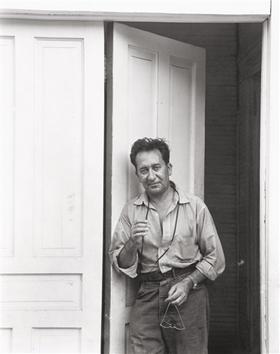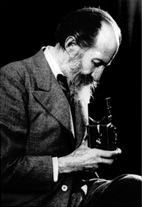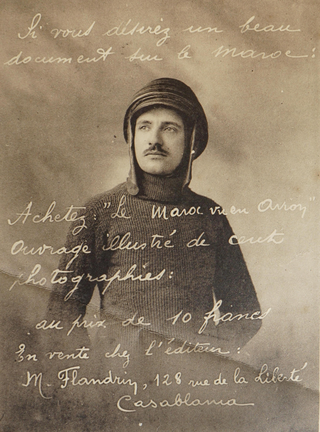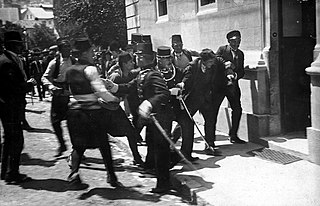Gallery
- Ouled Naïl girl, Algeria
- Arab youth
- Camel train in front of the Sultan Barkouk Mosque, Cairo
- Street in Cairo
- The Pyramids
- Jerusalem, Dome Rock
- Jewish worshippers at the Wailing Wall
- Girl named Ayada
Lehnert & Landrock was a photographic studio run by Rudolf Franz Lehnert and Ernst Heinrich Landrock active in Tunisia and Egypt in the early 20th century, noted for producing Orientalist images. [1] [2] Rudolf Franz Lehnert and Ernst Heinrich Landrock produced images of North African people, landscapes, and architecture for a primarily European audience. [1] These images were mainly distributed in monographs, though also as original prints, photogravures, and lithographic postcards. [1]
Rudolf Franz Lehnert (13 July 1878 – 16 January 1948) was born in Gross Aupa, Bohemia (now Velká Úpa, Czech Republic), and Ernst Heinrich Landrock (4 August 1878 – 30 April 1966) in Reinsdorf, Saxony, Germany. [3] Lehnert was raised by his uncle in Vienna and studied photography at the Vienna Institute of Graphic Arts. After finishing his studies he used money inherited from his parents to travel abroad with his camera and in 1903 made his first trip to Tunisia. [4] In 1904, on his return to Europe, Lehnert met Landrock, who was studying in Switzerland, and the two decided to become business partners, founding the firm Lehnert & Landrock, with Lehnert taking the photographs and Landrock being the business administrator. They travelled to Tunisia in 1904 and opened a photography shop in Avenue de France, Tunis that Lehnert used as a base for his various photographic expeditions in the Maghreb while Landrock organised the photo laboratory, and the marketing of the resultant prints and postcards. [5] [2]
At the beginning of WW1, the shop was closed when martial law was declared in French colonies and, on 4 August 1914, Lehnert was arrested, made a prisoner of war and sent to an internment camp in Corsica, while Landrock was held in Switzerland. After the war, and following the return of their confiscated glass plates, they initially set up a business in Leipzig. [6] Before long Lehnert was on the move again, travelling to the Middle East; Egypt, Palestine and Lebanon. In 1924 the partners moved to Cairo setting up a similar business to the one in Tunis but branching out "into the entire photo gamut - postcards, larger-sized photos, greeting cards and fine art prints" [6] for the European market particularly pandering to the cult of orientalism and the popularity of postcards. In 1930 the partnership was dissolved when Lehnert moved back to Tunis, and opened a studio as a portrait photographer,. Landrock continued to run the studio and shop in Sherif Street, Cairo until the outbreak of WW2, when he returned to Germany in 1938. [7] [8] At that time, Kurt Lambelet, Landrock's stepson, took over the business turning it into a large book shop in the 1950s. [9] The family run shop still remains at its original location. [7] [10]
In 1982, Dr Edward Lambelet, who had joined his father Kurt in the business, discovered the glass plate negatives of Lehnert and Landrock which were catalogued and printed, immediately becoming popular again. [6] As Joseph Gareci states in his 2015 article 'Lehnert and Landrock of North Africa' for the journal History of Photography , in which he investigates the "subset of the Lehnert & Landrock oeuvre, a series of figure studies of North African people made by Lehnert from 1904 to 1914, and again from 1930 to 1939, as a method of exploring East-West interactions and imaginings", there was renewed interest in their work by both scholars and collectors in the 1980s. [1] Wikipedia Commons has a large number of images under the category 'Lehnert & Landrock' that includes a subcategory 'Orientalist nude photographs by Lehnert & Landrock'. [11] Whilst the landscape photographs are considered "the most ubiquitous surviving Orientalist imagery of North Africa in the early 20th century....that present a highly idealised vision of romantic Orientalism", [12] the often eroticised images of nude or partially nude women and children are more controversial. [13]
The renewed interest in the photographs resulted in a number of publications, the first being Lehnert & Landrock : L'orient d'un Photographe in 1987 by Philippe Cardinal followed by others, for example, Tunis 1900 - Lehnert & Landrock photographes by Michel Meguin, and a number of exhibitions of their work. [14] [6] Photographs by Lehnert & Landrock are also held in the undermentioned collections -;
British Museum, London [15]
Conway Library, The Courtauld Institute of Art, London [16]
J. Paul Getty Museum, Los Angeles [17]
Library of Congress, Washington, DC [18]
University of Pennsylvania Museum of Archaeology and Anthropology, Philadelphia [19]
Royal Academy of Arts, London [20]
The Science Museum, London [21]
Victoria and Albert Museum, London [22]

Oscar Gustave Rejlander was a pioneering Victorian art photographer and an expert in photomontage. His collaboration with Charles Darwin on The Expression of the Emotions in Man and Animals has assured him a position in the history of behavioural science and psychiatry.

Jean-Baptiste Gustave Le Gray was a French painter, draughtsman, sculptor, print-maker, and photographer. He has been called "the most important French photographer of the nineteenth century" because of his technical innovations, his instruction of other noted photographers, and "the extraordinary imagination he brought to picture making." He was an important contributor to the development of the wax paper negative.
Irving Penn was an American photographer known for his fashion photography, portraits, and still lifes. Penn's career included work at Vogue magazine, and independent advertising work for clients including Issey Miyake and Clinique. His work has been exhibited internationally and continues to inform the art of photography.
Erotic photography is a style of art photography of an erotic, sexually suggestive or sexually provocative nature.

Aaron Siskind was an American photographer whose work focuses on the details of things, presented as flat surfaces to create a new image independent of the original subject. He was closely involved with, if not a part of, the abstract expressionist movement, and was close friends with painters Franz Kline, Mark Rothko, and Willem de Kooning.

Francis Frith was an English photographer and businessman. Francis Frith & Co., the company he founded in 1860 with the initial goal of photographing every town and village in England, quickly became the largest photographic publishers in the world and eventually amassed a collection of 330,000 negatives covering over 7,000 population centres across Great Britain and Ireland.

Antonio Beato, also known as Antoine Beato, was an Italian-British photographer. He is noted for his genre works, portraits, views of the architecture and landscapes of Egypt and other locations in the Mediterranean region. He was the younger brother of photographer Felice Beato (1832–1909), with whom he sometimes worked. Antonio and his brother were part of a small group of commercial photographers who were the first to produce images of the Orient on a large scale.
Maison Bonfils was a French family-run company producing and selling photography and photographic products from Beirut from 1867 until 1918, from 1878 on renamed "F. Bonfils et Cie". The Bonfils ran the first and, in their time, most successful photographic studio in the city. Maison Bonfils produced studio portraits, staged biblical scenes, landscapes, and panoramic photographs.
Underwood & Underwood was a producer and distributor of stereoscopic and other photographic images, and later was a pioneer in the field of news bureau photography.

Rudolf Franz Lehnert was an Austrian photographer. He was noted for producing Orientalist images.
Ernst Heinrich Landrock was a photographer who was based in Tunis, Leipzig and Cairo. He is known for his works with Rudolf Franz Lehnert, published as "Lehnert & Landrock".

Rudolf Koppitz was an Austrian photographer. He moved to Vienna and was a Photo-Secessionist whose work includes straight photography and modernist images. He was one of the leading representatives of art photography in Vienna between the world wars. Koppitz is best known for his works of the human figure including his iconic Bewegungsstudie, "Motion Study" and his use of the nude in natural settings.

Nude is a black and white photograph taken by Edward Weston in 1936. It shows an apparently nude woman with her arms wrapped around her legs while she sits on a blanket in bright sunlight against a darkened doorway. The dynamic balance of the light and dark accentuate the curves and angles of the woman's body; at the same time her face and all but the slightest hint of her pubic area are hidden from view, requiring the viewer to concentrate on her arms, legs, feet and hands. It is an image of a nude that concentrates solely on the forms of the body rather than the sexuality. The model was his muse and assistant, Charis Wilson, whom he married a year later.
A French postcard is a small, postcard-sized piece of cardstock featuring a photograph of a nude or semi-nude woman. Such erotic cards were produced in great volume, primarily in France, in the late 19th and early 20th century. The term was adopted in the United States, where such cards were not legally made. The cards were sold as postcards, but the primary purpose was not for sending by mail, as they would have been banned from delivery. The cards sometimes even depicted naked lesbians. French street vendors, tobacco shops and a variety of other vendors bought the photographs for resale to tourists.

Gabriel Lekegian, also known as G. Lékégian, was an Armenian painter and photographer, active in Constantinople and Cairo from the 1880s to the 1920s. Little is known about his life, but he left an important body of work under the name of his studio ‘Photographie Artistique G. Lekegian & Cie’. With a large number of now historical photographs of Ottoman Egypt, he documented the country at the turn of the 19th century. Among other collections, his photographs are held in the New York Public Library and the Victoria and Albert Museum, London.

Marcelin Flandrin (1889–1957) was a French military photographer.

Photography in Sudan refers to both historical as well as to contemporary photographs taken in the cultural history of today's Republic of the Sudan. This includes the former territory of present-day South Sudan, as well as what was once Anglo-Egyptian Sudan, and some of the oldest photographs from the 1860s, taken during the Turkish-Egyptian rule (Turkiyya). As in other countries, the growing importance of photography for mass media like newspapers, as well as for amateur photographers has led to a wider photographic documentation and use of photographs in Sudan during the 20th century and beyond. In the 21st century, photography in Sudan has undergone important changes, mainly due to digital photography and distribution through social media and the Internet.
Philip Adolphe Klier, also known as Philip Klier, was a German photographer, who arrived in Burma as a young man around 1865 and spent the rest of his life there. Mainly working as self-trained photographer and businessman, Klier took hundreds of photographs at the end of the 19th century during the British colonial period in Burma. His photographs, taken both in his studio as well as on location, were mainly sold as picture postcards for foreign visitors. They have also been published in several books and collected in public archives. Among a small number of other photographers, Klier is considered as one of the earliest professional photographers in the history of today's Myanmar.

Arrest of a Suspect in Sarajevo, also erroneously identified as The Arrest of Gavrilo Princip, is a historically significant photograph that captured the immediate aftermath of the assassination of Archduke Franz Ferdinand of Austria and his wife Sophie, Duchess of Hohenberg, in Sarajevo on 28 June 1914. Originally believed to depict the apprehension of the assassin, Gavrilo Princip, the image gained widespread attention after appearing on the front cover of the Austrian weekly newspaper Wiener Bilder on 5 July 1914. This portrayal played a crucial role in stirring patriotic sentiments that unified allied nations at the outset of World War I.
Nude, 1925, also known as Torso, is a black and white photograph taken by American photographer Edward Weston in 1925. It is part of a series of six nude photographs of his model and lover, Miriam Lerner.